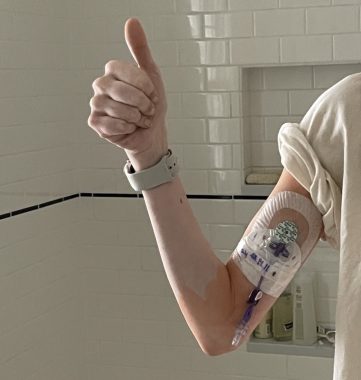My Recent Procedure Shed New Light on Old Medical Trauma
Columnist Anna Jeter faces old fears during a PICC line placement

“And if the oral antibiotic doesn’t work, they did mention they might want to do an IV antibiotic with a PICC line. But we’ll cross that bridge when we come to it.”
My mom reluctantly tacked this onto the end of our discussion. She had been summarizing a conversation she’d had with my transplant coordinator, avoiding the punchline. But she also knew she couldn’t keep the planned course of action from me.
The news wasn’t surprising. I’ve been battling lung infections on and off for a year now, and oral antibiotics are proving to be an ineffective solution. Still, I instantly felt anxious.
Throughout my years of undergoing procedures and operations, some processes have been more difficult than others. Few medical interventions are considered desirable, but I have a short list of things that raise the red flag of anxiety quicker than others.
One of these is IV line placements. I had my first PICC line in middle school when my central line became infected and we needed alternative access for my Remodulin (treprostinil) medication while the infection cleared.
I was anxious about the procedure, so I was given medication to help me relax. Unfortunately, it had the opposite effect, and I became hysterical during the placement. This negative experience had a lasting impact on me, and I forever associated PICC line placement with the dread and helplessness I felt at that moment.
Again, this fear was based more on the specific situation than the overall procedure. In fact, just 30 minutes later, I was eating mac and cheese and chatting with my mom, who had whiplash from the change in my demeanor. Still, we both left that experience with a deep dislike for PICC lines.
I was fortunate to avoid many line placements in the years that followed, but I made up for it in the months after my heart-lung transplant. During my prolonged recovery, I had many PICC lines, as well as arterial lines and one central line. The placement of these was often a difficult affair, involving multiple attempts. I even struggled with the removal of an old central line from before transplant.
While these experiences have become dulled over time, they’ve also ingrained in me an even deeper repulsion for line placements.
So when my oral antibiotics failed again and my doctor ordered a PICC line placement, those residual feelings of anxiety instantly took root. In the days leading up to the procedure, I was surprised by how heavy and distracted I felt.
Still, I’m more equipped to deal with these stressors now than when I was in seventh grade. I quickly took action to meditate, reminding myself that my body was safe for the time being, and the threats I was anticipating were not yet anything to worry about.
I also reminded myself that this would be a controlled, anticipated procedure, and it could only last for a finite amount of time — time that had to pass. I would not be hospitalized, and it would not be like before. The period of pain would only last so long.
The truth is, a lot of my fear ended up feeling foolish. So much of it was in my head. When the day arrived, my team was patient and kind. And the PICC line placement was relatively uneventful. I would even describe the process as uncomfortable rather than painful. Not at all like I remembered it.

Anna gives a thumbs-up following her PICC line placement in November. (Courtesy of Anna Jeter)
This was a reminder that much of my trauma is rooted in the state of my health or the emergence of a given situation, rather than the actual difficulty or pain of the procedure itself. It also helped me realize how much time and joy is forsaken when I allow worry to overshadow reality.
There have certainly been interventions throughout my life with pulmonary hypertension and transplant that have been worth a bit of anxiety. Not everything can be excused as less horrible than expected. But many things do end up being much more tolerable than what my anxiety turns them into in my head.
I’m proud of myself for using coping mechanisms prior to this procedure to remind myself that I am capable of tolerating uncomfortable things. And I’m grateful to understand now more than ever that each experience is worthy of its own evaluation and conclusion.
I never want to minimize the difficulties of life with chronic illness. I have been required to endure so much for the sake of daily survival, and that deserves to be acknowledged. But I also know that I’m being made more resilient through it all, and in the end, I will always prove to be stronger than I believe myself to be.
Note: Pulmonary Hypertension News is strictly a news and information website about the disease. It does not provide medical advice, diagnosis, or treatment. This content is not intended to be a substitute for professional medical advice, diagnosis, or treatment. Always seek the advice of your physician or other qualified health provider with any questions you may have regarding a medical condition. Never disregard professional medical advice or delay in seeking it because of something you have read on this website. The opinions expressed in this column are not those of Pulmonary Hypertension News or its parent company, Bionews, and are intended to spark discussion about issues pertaining to pulmonary hypertension.









Leave a comment
Fill in the required fields to post. Your email address will not be published.